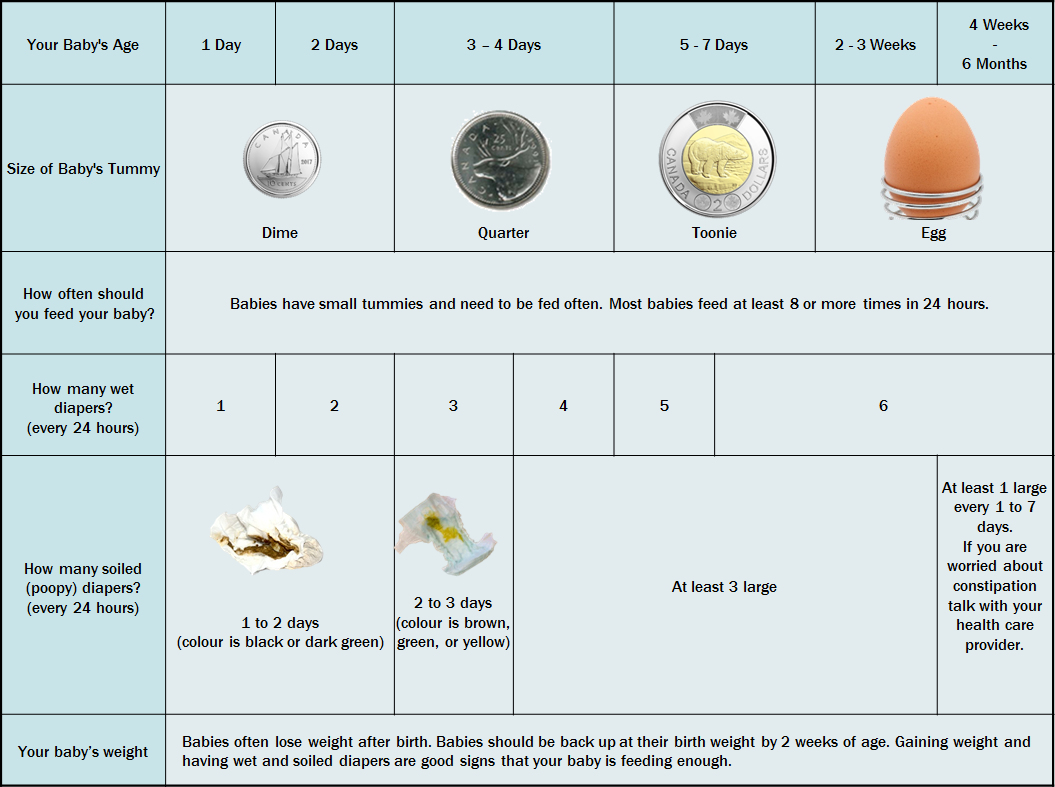Bottle Feeding 101
Babies will feed often as they have tiny tummies. Feed your baby when she wants to eat. This is called cue-based feeding. Start out with a small amount of formula at each feed. Slowly increase the amount to meet your baby’s growing needs. To get an idea of the size of your baby’s growing stomach, see the table below.
Size of babies’ tiny tummies:

When is the best time to feed my baby?
The best time to feed your baby is she shows you signs that she is hungry. This is usually when baby first wakes up. In the early months, new parents need to be flexible so they can adapt to baby’s changing sleep and feeding schedules.
Signs Your Baby is Hungry
In the first few months of life most babies will need to eat many times throughout a 24 hour period (at least eight times). This means they will eat during the day and during the night. This is normal and can last many months. Every baby grows at a different rate so they may need more feedings overnight. Your baby will let you know when they are hungry.
Signs (feeding cues) that your baby is hungry:
- sucks on fingers, hands or tongue
- smacks lips
- opens mouth when you touch their cheek (rooting)
- turns head towards you rooting for nipple
It’s important to watch for these signs. Waiting until your baby is crying may make feeding them difficult. Crying is considered a late sign of hunger.
How can I give my baby the best feeding experience?
- Hold your baby skin-to-skin while feeding. Your close contact is so important to your relationship with your baby. Propping the bottle does not build attachment and can cause choking, tooth decay and ear infections.
Tips for pace feeding your baby:
- Hold your baby so that their head is a bit higher than their body. Tilt the bottle only a little, keeping it almost flat. This slows down the flow of milk and helps prevent choking. Choose a low flow nipple, this also helps prevent overeating and slows the flow.
- Let them feed at their own pace and eat much or as little as they want.
- Burp part way through the feed and after they are finished.
- Watch for signs of distress during feeding
Note: Other videos may be recommended by the host channel (e.g. YouTube, Vimeo). These suggestions may be based on your personal search history and other factors. The WRHA does not control these suggestions and is not responsible for and may not endorse the content.
What are the signs that my baby is in distress when feeding?
- Choking or gagging
- Milk leaking from baby’s mouth
- Gulping and swallowing quickly without taking a breath
- Having a hard time breathing or catching her breath
- Making smacking or squeaking noises
- Squirming and pushing the bottle away with her hands.
- Face looks stressed
If your baby is showing signs of distress, stop feeding your baby. You can burp your baby and wait until she shows signs of readiness (hands in the mouth, rooting, smacking lips) before starting to feed again. Your baby may be full and not ready to feed right away.
How can I tell if my baby is full?
Your baby will:
- Slow down or stops sucking
- Close her mouth
- Turn her head away
- Push the bottle away
- Fall asleep
Following your baby’s feeding cues will prevent over-feeding. Do not pressure your baby to finish the bottle if she is full. Your baby may still make sucking movements when finished feeding, this is common baby behaviour.
Hot Parent Tips:
- Your baby may want to eat more during growth spurts. So keep feeding your baby based on their feeding cues. Growth spurts usually occur when babies are two to three weeks, six weeks, three months and six months of age.
- Never add infant cereal to your baby’s bottle of formula.
- Wait until your baby is six months to introduce solid foods.
References:
How to Feed Your Baby with Infant Formula- A Nova Scotia Resource
Infant Formula: What you Need to Know- A Best Start Ontario Resource